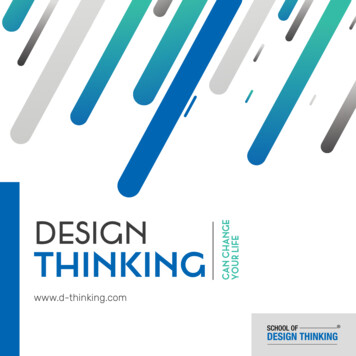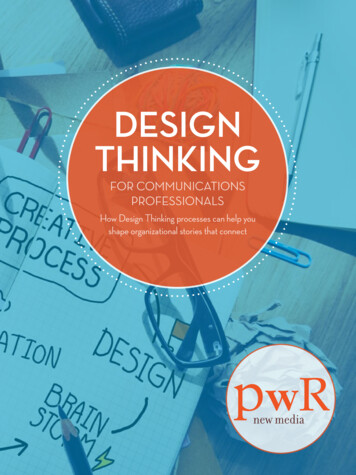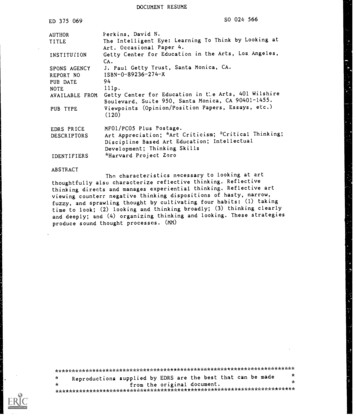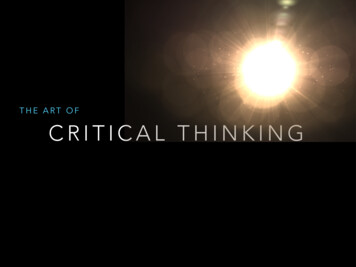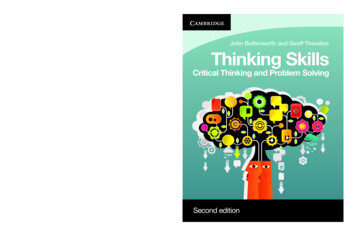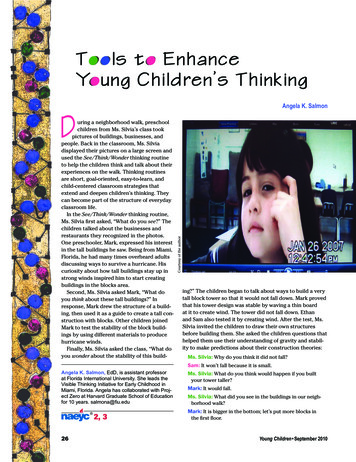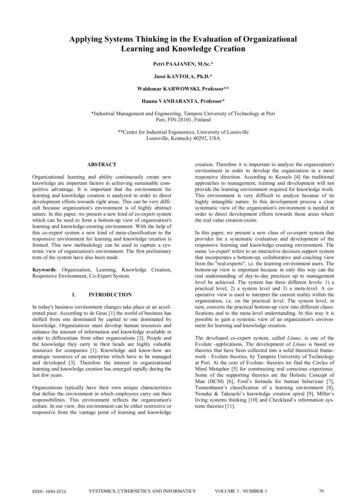
Transcription
Applying Systems Thinking in the Evaluation of OrganizationalLearning and Knowledge CreationPetri PAAJANEN, M.Sc.*Jussi KANTOLA, Ph.D.*Waldemar KARWOWSKI, Professor**Hannu VANHARANTA, Professor**Industrial Management and Engineering, Tampere University of Technology at PoriPori, FIN-28101, Finland**Center for Industrial Ergonomics, University of LouisvilleLouisville, Kentucky 40292, USAABSTRACTOrganizational learning and ability continuously create newknowledge are important factors in achieving sustainable competitive advantage. It is important that the environment forlearning and knowledge creation is analyzed in order to directdevelopment efforts towards right areas. This can be very difficult because organization's environment is of highly abstractnature. In this paper, we present a new kind of co-expert systemwhich can be used to form a bottom-up view of organization'slearning and knowledge-creating environment. With the help ofthis co-expert system a new kind of meta-classification to theresponsive environment for learning and knowledge creation isformed. This new methodology can be used to capture a systemic view of organization's environment. The first preliminarytests of the system have also been made.Keywords: Organization, Learning, Knowledge Creation,Responsive Environment, Co-Expert System.1.INTRODUCTIONIn today's business environment changes take place at an accelerated pace. According to de Geus [1] the world of business hasshifted from one dominated by capital to one dominated byknowledge. Organizations must develop human resources andenhance the amount of information and knowledge available inorder to differentiate from other organizations [2]. People andthe knowledge they carry in their heads are highly valuableresources for companies [1]. Knowledge and know-how arestrategic resources of an enterprise which have to be managedand developed [3]. Therefore the interest in organizationallearning and knowledge creation has emerged rapidly during thelast few years.Organizations typically have their own unique characteristicsthat define the environment in which employees carry out theirresponsibilities. This environment reflects the organization'sculture. In our view, this environment can be either restrictive orresponsive from the vantage point of learning and knowledgeISSN: 1690-4524creation. Therefore it is important to analyze the organization'senvironment in order to develop the organization in a moreresponsive direction. According to Kessels [4] the traditionalapproaches to management, training and development will notprovide the learning environment required for knowledge work.This environment is very difficult to analyze because of itshighly intangible nature. In this development process a clearsystematic view of the organization's environment is needed inorder to direct development efforts towards those areas wherethe real value creation exists.In this paper, we present a new class of co-expert system thatprovides for a systematic evaluation and development of theresponsive learning and knowledge-creating environment. Thename 'co-expert' refers to an interactive decision support systemthat incorporates a bottom-up, collaborative and coaching viewfrom the "real-experts", i.e. the learning environment users. Thebottom-up view is important because in only this way can thereal understanding of day-to-day practices up to managementlevel be achieved. The system has three different levels: 1) apractical level, 2) a system level and 3) a meta-level. A cooperative view is used to interpret the current reality within theorganization, i.e. on the practical level. The system level, inturn, converts the practical bottom-up view into different classifications and to the meta-level understanding. In this way it ispossible to gain a systemic view of an organization's environment for learning and knowledge creation.The developed co-expert system, called Lituus, is one of theEvolute -applications. The development of Lituus is based ontheories that have been collected into a solid theoretical framework - Evolute theories, by Tampere University of Technologyat Pori. At the core of Evolute- theories we find the Circles ofMind Metaphor [5] for constructing real conscious experience.Some of the supporting theories are the Holistic Concept ofMan (HCM) [6], Ford’s formula for human behaviour [7],Tannenbaum’s classification of a learning environment [8],Nonaka & Takeuchi’s knowledge creation spiral [9], Miller’sliving systems thinking [10] and Checkland’s information systems theories [11].SYSTEMICS, CYBERNETICS AND INFORMATICSVOLUME 3 - NUMBER 379
2.ORGANIZATIONS AS LIVING SYSTEMSIn our research we treat organizations as living systems to get asystematic view of their functions and structure. Miller's theoryof living systems analyzes the structure and process of the livingsystem's seven hierarchical levels [10]. These levels are: cell,organ, organism, group, organization, society and supranationalsystem. According to Miller [10] the systems have at each level19 subsystems which process inputs, throughputs and outputs ofvarious forms of matter, energy and information. Nonaka andTakeuchi [9] also treat organizations as living organisms insteadof seeing them only as information processing machines. Theyalso argue that highly subjective insights, intuitions and hunchesare integral part of knowledge. Based on the living systemstheory Samuelson [12;13] has presented a model of the livingsystem's behaviour (Figure 1).positive events: learning, applying new skills/knowledge andrecognition can increase self-confidence in learning new skillsand performing them efficiently [8]. There are different kinds ofapproaches to organizational learning. Figure 2 presents oneapproach, called the organization's learning cycle.Organization's actionsThe development oforganization's mentalmodels, actions andknow-howFeedback systemsThe interpretation oforganization's sharedknowledge (vision,strategy and goals)Figure 2: The organization's learning cycle [16].Figure 1: The living system and subsystem functions[14;12;13].In Figure 1, (reconstructed by Österlund), the upper left sectionconsists of those functions dealing with the living system'sinformation and communication. The upper right section consists of those functions dealing with the living system's command and control. The left side of the lower section consists ofthose functions dealing with the living system's maintenanceand support. In turn, the lower right side consists of those functions dealing with the living system's operation and production.Together these four sections also form the general concepts oforganizational management: to keep and maintain a functioningsystem. In this paper, we present a responsive environment, asystem, for learning and knowledge creation which is based onthis important division between information - communicationmanagement, command - control management, maintenance support management and operation - production management,in order to keep the system up and running. The living system'stheory also reveals those important subsystems found inside thesystem, influencing its behaviour and growth.3.In this paper, we present a co-expert system which can be seenas a part of the organization's learning cycle. The organization'sactions and feedback systems depend on the organization'scapabilities. The co-expert system can be used to gather knowledge from the people working in the organization; the systeminterprets this knowledge and produces results according to thegiven input data. The results suggest those areas where development efforts would be most productive. This knowledge helpsin developing the organization's mental models, actions andknow-how. In the double-loop learning, information, feedbackabout the real world not only alters decisions within the contextof existing frames and decision rules but also within our mentalmodels [18]. It is therefore possible that the use of the co-expertsystem could lead to double-loop learning. The system givesinformation feedback about the real world which can contradictwith the dominant mental models of the organization. Consequently development efforts are directed in producing a moreresponsive environment for future learning and knowledgecreation. Thus, the co-expert system does not focus on shortterm improvements, but instead points out long range development guidelines.ORGANIZATIONAL LEARNINGAccording to Senge [15] individual learning does not guaranteeorganizational learning. However he also argues that withoutindividual learning no organizational learning occurs. Thereforeit is essential that an organization supports and facilitates individual learning and knowledge creation. This creates a chain of80The starting point of the organization's learning cycle is itspresent actions [16]. With the help of feedback systems, diversefeedback is systematically gathered. This feedback is then interpreted in order to gain new knowledge and to clarify vision,strategy and goals. It is then possible to develop the organization's mental models, actions and know-how. Sydänmaanlakka[16] also argues that strategic learning, an organization's abilityto detect weak signals and its ability to regenerate itself areemphasized in this process. The organization's learning cycle isclosely related to the single-loop and double loop learning, cf.[17].4.ORGANIZATIONAL KNOWLEDGE CREATIONIn order to succeed in business competition organizations musthave the ability to create new knowledge continuously. Knowledge is an important factor adding value to a firm's products andSYSTEMICS, CYBERNETICS AND INFORMATICSVOLUME 3 - NUMBER 3ISSN: 1690-4524
services. In our research we have adopted the theory of organizational knowledge creation introduced by Nonaka&Takeuchi[9]. In this theory, knowledge is created in a spiral processwhere tacit and explicit knowledge interact. This knowledgecreation process is based on four different modes of knowledgeconversion (SECI process) which are socialization, externalization, combination and internalization (Figure 3).Figure 3: The SECI process [19].Socialization (from tacit knowledge to tacit knowledge) is aprocess of sharing experiences; externalization (from tacitknowledge to explicit knowledge) is a process where tacitknowledge is articulated to explicit concepts; combination(from explicit knowledge to explicit knowledge) is a processwhere concepts are systemized into a knowledge system; internalization is a process where explicit knowledge is embodiedinto tacit knowledge and is closely related to learning by doing[9]. Malone argues that knowledge management must enablethe conversion of knowledge from tacit to explicit, in order toachieve goals set forth [20].Organizational knowledge creation starts at the individual leveland then moves up through communities of interaction crossingsectional, departmental, divisional and organizational boundaries [9]. This spiral process of organizational knowledge creation presents a systemic view on how organizations create newknowledge. It is vital that the organization offers an environment which supports and motivates creative individuals andfacilitates interaction between them. Nonaka&Takeuchi [9]describe five conditions which are required in order to promotethe knowledge spiral: intention; autonomy; fluctuation andcreative chaos; redundancy; requisite variety. If these conditionsare not put into practice it is impossible to continuously createnew knowledge in a spiral process. The knowledge spiral is theonly way to expand individuals' knowledge assets and createnew knowledge at an organizational level. A responsive environment comprises those factors which are essential in developing a positive learning environment and support to knowledgecreating activities. In the following section the characteristics ofa responsive environment are discussed.ISSN: 1690-45245.THE RESPONSIVE LEARNING AND KNOWLEDGE CREATION ENVIRONMENTA responsive environment is needed in order to motivate individuals in the process of learning and knowledge creation. Inour research we have constructed a responsive environment forlearning and knowledge creation, based on certain determiningfactors. Optimally, according to Ford [7], a responsive environment has the following four functional elements:1. It must be congruent with an individual's agenda ofpersonal goals.2. It must be congruent with the person's biological,transactional and cognitive capabilities.3. It must have the material and informational resourcesneeded to facilitate goal attainment.4. It must provide an emotional climate that supportsand facilitates effective functioning.A responsive environment must support the phases of theknowledge spiral as discussed in the previous section, yet itmust also support organizational learning, and therefore it isessential to identify which conditions occur in a positive learning environment. Tannenbaum [8] has presented eight conditions, which are characteristic of a positive learning environment:1. Individuals are aware of the big picture, see also [15].2. Individuals are assigned to tasks where they can applywhat they have learned and where they are stretchedand challenged, see also [21].3. Mistakes are tolerated during learning and early application, when individuals are trying new ideas andskills, see also [22;23].4. Individuals are accountable for learning, and performance expectations are high enough to necessitate continued personal growth, see also [24].5. Situational constraints on learning and performanceare identified and minimized.6. New ideas are valued and encouraged, see also [25].7. Supervisors and co-workers provide support allowingindividuals to learn and attempt to implement newideas, see also [21;26].8. Policies and practices support the effective use oftraining.These conditions reflect the learning organization's culture. Itcan be a time-consuming process to create a responsive environment because it demands a change in the organizationalculture. These are slow gradual processes, which can be difficult to detect and follow, cf. [15]. This is why a systemic viewis needed in the development process. The Lituus computerapplication can be used to detect and follow these processes.6.THE LITUUS COMPUTER APPLICATIONLituus is used to gather conscious experiences from the peoplewho are working in the organization. The database contains 97statements, which are used in the evaluation of an organization'senvironment in regard to learning and knowledge creation. Withthe help of these statements people evaluate the current realityand development needs (future vision) of the organization'senvironment. This way people transfer their own expertise toSYSTEMICS, CYBERNETICS AND INFORMATICSVOLUME 3 - NUMBER 381
the system. As a result Lituus gives a meta-classification to theresponsive environment for learning and knowledge creation,which connects the theoretical framework to the system's practice, cf. [11]. Table 1 shows how this system level is constructed.Table 1: Maintaining systems and maintaining systems' features.Maintaining SystemsMaintaining System's FeatureLeadershipHuman Resource ManagementManagement of Technical IssuesControl Systems(Command – Control, cf.Samuelson [13])Business ManagementConversation ManagementKnowledge ManagementFluctuation and Creative ChaosCommitmentMeasuring and EvaluationAutonomyWorking Systems(Operation – Production,cf. Samuelson [13])Team WorkRotation of PersonnelMentoringContinuous Improvement (Kaizen)RedundancyRequisite VarietyHuman CapitalInformation Systems(Information – CommuniIntellectual Assetscation, cf. SamuelsonDissemination of Local Knowledge[13])Knowledge ChannelsKnowledge ActivistsOrganizational CultureSupport Systems(Maintenance – Support,cf. Samuelson [13])tems and support systems. These systems form the metaclassification for a responsive environment for learning andknowledge creation. There are also 27 features which are divided into four maintaining systems. These features support andfacilitate the development of a positive learning environmentand knowledge-creating activities. This construction was possible by using fuzzy sets.Fuzzy sets are a mathematical way of representing vagueness inlinguistics [27;28]. Fuzzy systems provide decision support andpowerful reasoning capabilities. In general, as the complexity ofa system increases, our ability to make precise and yet significant statements about its behaviour diminishes [29]. Fuzzy logicwas applied in the Lituus co-expert system to cope with imprecise information related to the human decision-making processes and the natural fuzziness related to the evaluations madeby individuals.A general fuzzy logic controller consists of four modules [30]: afuzzification, inference, rulebase and defuzzification module.Lituus contains all these modules and operates through thefollowing phases:1. The statements describing the organization's environment for learning and knowledge creation are evaluated. All aspects of the learning and knowledgecreating environment are described in linguistic terms.Inputs are then converted into fuzzy sets (fuzzification).2. Fuzzified inputs are then used by an inference engineto evaluate dynamically created fuzzy rules in rulebase(s). This results in one fuzzy set for each environment's feature (inferencing).3. Fuzzy sets are then converted into crisp feature values, and furthermore to reports: graphics for individuals and groups, statistical reports for individuals andgroups.4. Fuzzy sets are finally converted into crisp metaclassification values, and again to reports: graphics forindividuals and groups, statistical reports for individuals and groups.A fuzzy logic based co-expert system ‘reveals’ to its users howdemanding it is to design or plan a complex object well. Theobject in this context is the organizational change towards aresponsive environment for learning and knowledge creation.Such a decision support system (Lituus) identifies those areaswhere the biggest potential for development exists. It also facilitates the applying of systems thinking in this developmentprocess. Figure 4 presents an example of how the use of Lituuscan lead to reinforcing and balancing feedback processes, cf.[15].Dimensions of CareSystems of IncentivesHuman Resources DevelopmentPolicyTools Supporting LearningAs can be seen from Table 1, Lituus consists of four differentsystems: control systems, working systems, information sys-82SYSTEMICS, CYBERNETICS AND INFORMATICSVOLUME 3 - NUMBER 3ISSN: 1690-4524
The Interpretation of zationalLearning andKnowledgeCreationDelayLimiting FactorsFigure 4: Reinforcing and balancing feedback processes.As the reinforcing loop in Figure 4 shows, people who areworking in the organization use Lituus to evaluate their organization from the vantage point of learning and knowledge creation. After these evaluation results are interpreted, actions basedon them can be taken. As a result of these development effortsthe organization's ability to learn and create new knowledgeshould improve, however here is a certain delay between actionstaken and the achieved improvements. In the balancing loop, thelimiting factors affect an organization's ability to learn andcreate new knowledge. This process also includes a certaindelay. The limiting factors can, for example, be a consequenceof incorrect interpretation of results.7.Figure 5: A graphical report describing evaluation results of themaintaining systems' features.The dark bar in Figure 5 represents the current state, while thelight bar (below) represents the developmental needs. The gapbetween these two represents the development potential. InFigure 5 these features are sorted by the development potential.Lituus also forms graphical reports about the system-level,which comprises of four maintaining systems: control systems,information systems, working systems and support systems,Figure 6.RESEARCH RESULTSLituus has already been tested in two case studies. These preliminary tests showed that Lituus is capable of showing anorganization's development potential of responsive environmentfor learning and knowledge creation. Figure 5 shows how individuals see the development potential of the 27 maintainingsystems' features taken from the Lituus report.Figure 6: A graphical report describing the evaluation results ofthe maintaining systems.This meta-classification (four maintaining systems and 27maintaining systems' features) helps managers to understandnew management issues from the systemic viewpoint. WhenLituus is used frequently in the organization, it is possible to seehow these issues develop over time.8.CONCLUSIONSThe first preliminary tests have shown that with the help ofLituus a systemic view of organization's learning and knowl-ISSN: 1690-4524SYSTEMICS, CYBERNETICS AND INFORMATICSVOLUME 3 - NUMBER 383
edge creation environment can be formed. Lituus forms a metaclassification to the responsive environment for learning andknowledge creation. Lituus can point out those areas whereorganization should direct its focus on development based onthis meta-classification. In the future more empirical results areneeded to improve the internal consistency of Lituus. We hopethat Lituus system will be used as a management tool thatprovides a systemic approach to the management of learningand knowledge-creating organizations.REFERENCES[1] A. de Geus, The Living Company, Boston: Harward Business School Press, 1997.[2] P. Ruohotie, J. Honka, Osaamisen kehittäminen organisaatiossa, Seinäjoki: Consulting team, 1997.[3] L. Otala, Oppimisen etu: kilpailukykyä muutoksessa,Porvoo: WSOY., 2000.[4] J.W.M. Kessels, "Learning in organizations: a corporatecurriculum for the knowledge economy", Futures 33 (6),2001, pp. 497-506.[5] H. Vanharanta, "Circles of mind. Identity and diversity inorganizations - building bridges in Europe", ProgrammeXIth European congress on work and organizationalpsychology, Lisboa, Portugal, 2003, 1.[6] H. Vanharanta, P. Pihlanto, "A New Theoretical Approachto Internet Applications Using the Holistic Concept of Manand the Theater Metaphor for Conscious Experience", 9 thInternational Conf. on HCI, New Orleans, Lousiana,USA, 2001.[7] M.E. Ford, Motivating Humans: Goals, Emotions, andPersonal Agency Beliefs, Newbury Park (CA): Sage, 1992.[8] S.I. Tannenbaum, "Enhancing Continuous Learning: Diagnostic Findings from Multiple Companies", Human Resource Management, Vol. 36, No. 4, 1997, pp. 437-452.[9] I. Nonaka, H. Takeuchi, The Knowledge-Creating Company: How Japanese Companies Create the Dynamics ofInnovation, New York: Oxford University Press., 1995.[10] J.G. Miller, Living Systems, New York: McGrew-Hill,1978.[11] P. Checkland, Systems Thinking, Systems Practice,Chichester: Wiley, 1999.[12] K. Samuelson, General information systems theory indesign, modelling and development. Information sciencein action, 304-320. Nato Advanced Study Institute, Nijhoff,Boston - The Hague, 1978.[13] K. Samuelson, "InformatiCom and multiway video communication as a cybernetic design and general systemstechnology", Proceedings SGSR 25th annual conferencein Toronto, 1981.[14] J. Österlund, Competence Management by InformaticsSystems in R&D Work, Stockholm Royal Institute ofTechnology, 1994.[15] P.M. Senge, The fifth discipline: The art and practice ofthe learning organization, New York: Doubleday, 1991.[16] P. Sydänmaanlakka, Älykäs organisaatio: tiedon, osaamisen ja suorituksen johtaminen, Helsinki: KauppakaariOyj, 2001.84[17] C. Argyris, D. Schön, Organizational Learning II: Theory, Method and Practice, Reading (MA): AddisonWesley, 1996.[18] J.D. Sterman, Business dynamics: systems thinking andmodeling for a complex world, Boston (MA): McGrewHill, 2000.[19] I. Nonaka, R. Toyama, N. Konno, "SECI, Ba and Leadership: a Unified Model of Dynamic Knowledge Creation",Long Range Planning 33, 2000, pp. 5-34.[20] D. Malone, "Knowledge management A model for organizational learning", International Journal of AccountingInformation Systems, Vol. 3, Issue 2, 2002, pp. 111-123.[21] S.S. Dubin, Maintaining professional competence: Approaches to career enhancement, vitality, and successthroughout a work life. In S.L. Willis & S.S. Dubin (Eds.)Maintaining professional competence: Approaches tocareer enhancement, vitality, and success throughout awork life, 1990, pp. 9-43, San Francisco: Jossey-Bass.[22] L.K. Gundry, J.R. Kickul, C.W. Prather, "Building thecreative organization". Organizational Dynamics, 22,1994, pp. 22-37.[23] S.B. Sitkin, "Learning through failure: The strategy ofsmall losses", Research in Organizational Behaviour, 14,1991, pp. 231-266.[24] J.M. Rosow, R. Zager, Training-The Competitive Edge,San Francisco: Jossey-Bass, 1988.[25] M.E. McGill, J.W. Slocum, D. Lei, "Management practicesin learning organizations", Organizational Dynamics, 21,1992, pp. 5-17.[26] J.B. Tracey, S.I. Tannenbaum, M.J. Kavanagh, "Applyingtrained skills on the job: The importance of the workenvironment", Journal of Applied Psychology, 80, 1995,pp. 239-252.[27] A.L. Zadeh, Fuzzy sets, Information and Control, 1965,pp. 338-353.[28] C.T. Lin, C.S.G. Lee, Neural Fuzzy Systems - A NeuroFuzzy Synenergism to Intelligent Systems, Prentice-HallInc., 1996.[29] L.A. Zadeh, "Outline of a new approach to the analysis ofcomplex systems and decision processes", IEEE Transactions on systems, Man, and Cybernetics, Vol. 1, No. 1,pp. 28-44, 1973.[30] J.G. Klir, B. Yuan, Fuzzy Sets and Fuzzy Logic, Theoryand Applications, Pretice-Hall Inc., 1995.SYSTEMICS, CYBERNETICS AND INFORMATICSVOLUME 3 - NUMBER 3ISSN: 1690-4524
positive events: learning, applying new skills/knowledge and recognition can increase self-confidence in learning new skills and performing them efficiently [8]. There are different kinds of approaches to organizational learning. Figure 2 presents one approach, called the organization's learning cycle. Figure 2: The organization's learning .





